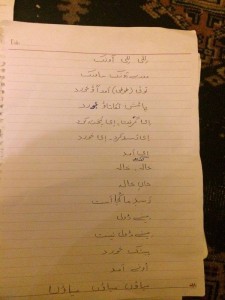Informant’s Background:
My informant, SV, is a recent graduate with a Master’s from the University of Southern California. He is 25, was born in Hyderabad, Telangana, India, and moved to the United States to attend a graduate program at USC. Post-graduation he remains in Los Angeles hunting for a job.
Context:
My informant, SV, is my roommate and a close friend of mine. I asked him if he could share some Indian traditions, customs, or folklore with me. NOTE: For this dialogue, I am AT.
Performance:
SV: “So… In India there’s a tradition of eating with your hands, and-which is quite common, and one of the, I guess, major rules or things that may offend someone is if you use your left hand to eat or grab things or get things. And the primary reason for this is it is considered unclean, because in older generations in India, uhm, when you’re cleaning yourself, uhm, after taking a shit… It’s usually using water and your hands, and most people are sort of taught to use their left hand, so that’s one of the reasons why your left hand is unclean, even though obviously you’re going to wash it with soap or gonna wash your hands. So that’s one of the kind of traditions there is that’s kind of prevalent in India.”
AT: “What if you’re left handed?”
SV: “So that’s sort of a weird, uhm… So the way it started was even if you’re left handed you use sort of- you use your right hand to eat or like you use your right hand to for example, if you’re in a shop or in someone’s house and you’re giving something or taking something from them you’re always taught to use your right hand, or maybe if it’s heavy both hands, but never your left hand. But uhm… Like, I don’t know, I think that maybe in slightly older time they didn’t want people to be left handed for this reason, but I think nowadays less emphasis is placed on this thing.”
Informant’s Thoughts:
SV: “Overall I think like… There’s sort of like some reason-like some reasoning behind it that is sort of valid to some extent. But like I guess like with modern like, uhm, advancements and like stuff like washing your hands with soap and I think now in most urban settings people have a bidet they use to wash their like, bodies once they’re taking a shit. So I don’t think it’s as big an issue, using your left hand, and now being left-handed or using your left handed doesn’t make you any worse than any other person. I think maybe if you were in some more rural areas and you used your left hand I think maybe some people might like be offended. But in general I think this is not very common a lot now.
Thoughts:
I had never really heard of anything like this until now, but I think SV is right in that it maybe seems like fairly sound reasoning in times before advancements in modern day sanitation and cleanliness. Upon some further research, it appears that the left hand is not only used for wiping one’s rear but also for other “unclean” actions as well, such as the removal of shoes, and cleaning your feet. Apparently left-handed activists in India today are attempting to fight prejudice against left-handed people, in schools some left-handed kids are taught to only use their right hand and are beaten for using their left. However overall, as SV said, it seems these practices and prejudices are fading in modern India.

